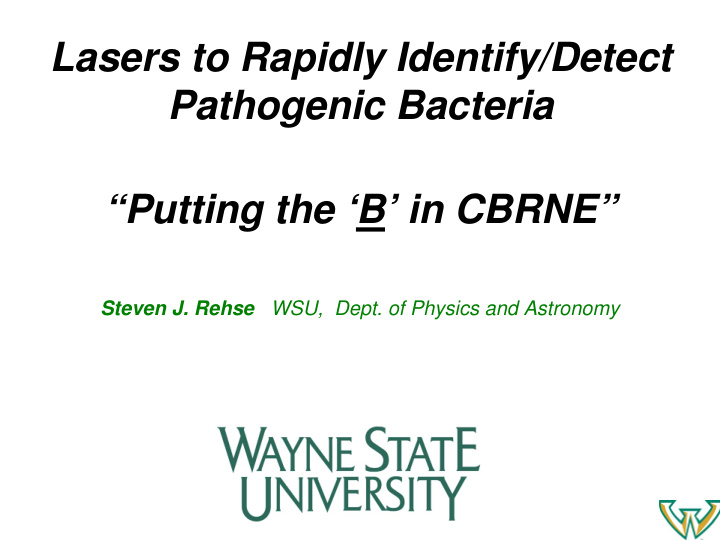



Lasers to Rapidly Identify/Detect Pathogenic Bacteria “Putting the ‘B’ in CBRNE” Steven J. Rehse WSU, Dept. of Physics and Astronomy
Why? “It is well-accepted that the microbiological expertise and cost required to perform these identifications preclude their common use as a screening mechanism to prevent human infection.” 1 1 Tarr, P.I. 1995. Escherichia coli O157:H7: clinical, diagnostic, and epidemiological aspects of human infection. Clin. Infect. Dis. 20 , 1-8.
What can we do? Although there are several alternative approaches to solving this problem, we feel the use of laser light is one of the best. We want to go from this… … to this!
Bacteria don’t have barcodes, but using lasers we can obtain unique patterns or fingerprints… Laser-induced breakdown spectroscopy can reveal a bacterium's atomic composition which provides a unique spectral fingerprint in real-time 1360 1310 1392 A 2.4 Wag31T73E Wag31T73A Raman spectroscopy can 2.0 Raman Intensity Wag31 WT reveal a bacterium's 1.6 (a.u.) molecular composition 1.2 which provides a unique 0.8 spectral fingerprint in real- 0.4 time 0.0 800 1000 1200 1400 1600
Advantage of using laser-based methods • identifications made quickly 10 microliter 10 microliter – (under 5 minutes, under 1 second?) • low cell count necessary • insensitive to contamination about 500-1500 about 500-1500 bacteria per bacteria per sampling location sampling location • safety – (dead bacteria, stand-off distances) • non-experts can use them easily • no biochemicals/consumables 11 mm 11 mm • computerized diagnoses
Who needs these techniques? (huge market demand) • food / beverage corporations • hygiene compliance officers / FDA • clean water utilities / EPA • first responders • clinicians: hospitals / physicians / CDC • military medicine • NASA / exo-biologists
We Must Proceed, and Faster… LIBS and Raman research must proceed along two equally important avenues: • fundamental research to explore the microbiological diversity that can occur in specimens • specimen preparation and handling protocols and techniques to isolate pathogens from contaminants of biological origin NOTE: we do NOT need to fingerprint hundreds and hundreds of “new” bacteria
Thank you • My collaborators Sunil Palchaudhuri WSU, Dept. of Immunology and Microbiology Hossein Salimnia WSU, Dept. of Pathology / Detroit Medical Center Choong-Min Kang WSU, Dept. of Biological Sciences Tom Haddock Translume, Inc., Ann Arbor, MI Andrzej Miziolek US Army Research Laboratory, APG, MD • My students Qassem Mohaidat WSU, Dept. of Physics and Astronomy Khozima Hamasha WSU, Dept. of Physics and Astronomy Caleb Ryder WSU, Dept. of Physics and Astronomy
Back-up slides
LIBS: The Wayne State Team has already demonstrated… LIBS spectral fingerprint is: – growth-medium independent – independent of state of growth (how “old” the bacteria are) – independent of whether the bacteria are live or dead (or inactivated by UV light) – obtainable even when other types of bacteria or contaminants are present (mixed samples) – obtainable even when other biochemicals are present – capable of strain discrimination – obtainable from about 500 bacteria The Raman spectral fingerprint: – is more sensitive than a LIBS fingerprint – requires more bacteria (lower SNR) – can identify biochemical changes in closely-related mutants due to protein phosphorylation – can be obtained from cell envelope fractions – can easily discriminate multiple E. coli strains – can be obtained from proteins – can be used to track metabolic or carbolic activity
EMMA: Elemental Multivariate Microbiological Analysis • utilizes laser-induced breakdown spectroscopy (LIBS) to measure the unique atomic or elemental composition of bacteria Nd:YAG laser (1064 nm, 8 ns) Laser-Induced Breakdown Spectroscopy spectrometer LIBS Spectrum is like a Bar Code- Unique for Each Sample
Microfluidic separation/concentration (Translume, Inc. Ann Arbor, MI) laser trap optical trap-based separation of bacteria heavier cells from lighter cells only hydrodynamic (microfluidic) separation of heavier cells from lighter cells monolithically fabricated devices in glass
Recommend
More recommend